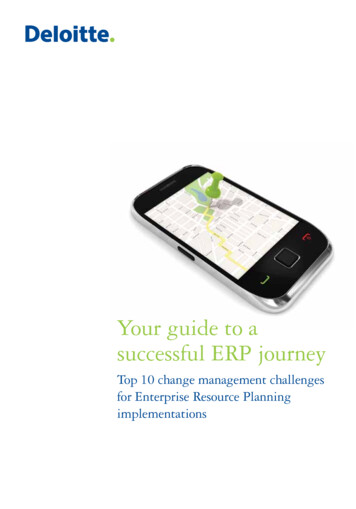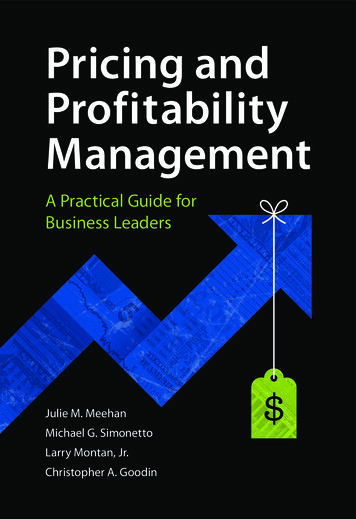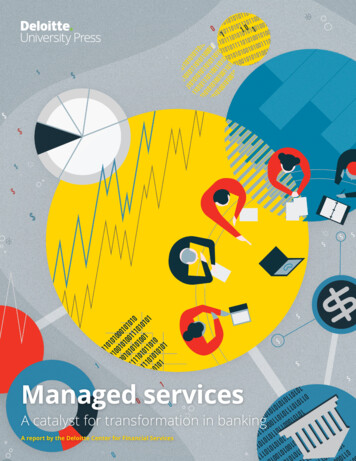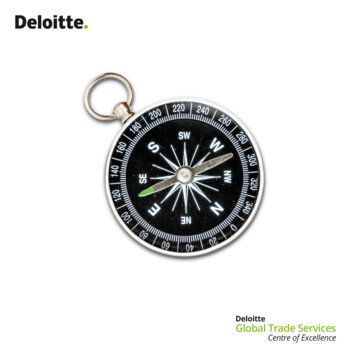
Transcription
COVID-19: Managing cash flow during a period of crisisCOVID-19Managing cash flow during a period of crisisi
COVID-19: Managing cash flow during a period of crisisii
COVID-19: Managing cash flow during a period of crisisAs a typical “black swan” event, COVID-19 took the world by complete surprise.This newly identified coronavirus was first seen in Wuhan, the capital of Hubeiprovince in central China, on December 31, 2019. As we enter March 2020,the virus has infected over 90,000 people, and led to more than 3,000 deaths.More importantly, more than 75 countries are now reporting positive cases ofCOVID-19 as the virus spreads globally, impacting communities, ecosystems, andsupply chains far beyond China.The focus of most businesses is now on protecting employees, understanding therisks to their business, and managing the supply chain disruptions caused by theefforts to contain the spread of COVID-19. The full impact of this epidemic onbusinesses and supply chains is still unknown, with the most optimistic forecastspredicting that normalcy in China may return by April,1 with a full global recoverylagging depending on how other geographies are ultimately affected by the virus.However, one thing is certain: this event will have global economic and financialramifications that will be felt throughout global supply chains, from raw materialsto finished products.Our recent report, COVID-19: Managing supply chain risk and disruption, provided 25recommendations for companies that have business relationships and supply chainflows to and/or from China and other impacted geographies. One of theserecommendations was to focus on cash flow. Supply chain disruptions havecash flow implications across the extended supply chain that can’t be underestimated.This paper will suggest ways organizations can mitigate damages to their businessduring this volatile 2050VF11
COVID-19: Managing cash flow during a period of crisisCompanies that willbe hit the hardestA survey jointly conducted by Tsinghua Universityand Peking University estimates that 85 percentof small and medium sized enterprises (SMEs) inChina will run out of cash within three months, andtwo thirds will run out of money in two months,if the crisis does not abate.2 The People’s Bank ofChina has announced it will provide 300 billion yuan(US 42 billion) in low-cost loans for banks to lend tobusinesses affected by the virus. Several municipaland provincial governments have also announcedmeasures to help SMEs, with total support estimatedin the US 70 billion range. However, the impact onbusinesses will extended far beyond China, and willonly get worse if the virus continues to spread.Businesses in sectors such as tourism, hospitality,entertainment and air transportation have beenparticularly hard-hit in the short term. Businessesin consumer goods and retail may also be at higherthan-normal financial risk, especially those with a highexposure to China, and those in seasonal businesseswhere demand may be lost (as opposed to shifted),such as such perishable consumer goods and seasonalapparel. Even commodity-oriented industries, suchas metals and mining or oil and gas, are exposedas global demand shifts and pricing fluctuates.Businesses that are currently struggling forprofitability—those with low cash reserves orunstable cash flows— are particularly vulnerable.However, even businesses that appear to be in goodfinancial shape may not be immune, depending onhow the situation progresses, and how long it takesfor demand and supply chains to return to economy/global-economic-outlook/weekly-update.html
COVID-19: Managing cash flow during a period of crisisResponding to theimmediate challengeactivities such as paying bills and turning receivablesinto cash are often taken for granted. In the currentabnormal business conditions, smart companiesare shifting their focus from the income statement tothe balance sheet. Of the three elements of supplychain working capital–payables, receivables, andinventory–, supply chain executives have a tendencyto focus on inventory. But, in order to minimizeworking capital requirements during challengingtimes, it’s important to apply a coordinatedapproach that addresses all three areas.Given the importance of cash flow in times like this,companies should immediately develop a treasury planfor cash management as part of their overall business riskand continuity plans. In doing so, it is essential to take a fullecosystem and end-to-end supply chain perspective, as theapproaches you take to manage cash will have implicationsfor not only your business but also for your customers.Borrowing from the lessons learned from the SARSoutbreak in 2003, the 2008 recession and credit crunch,and the last black swan event to significantly impact globalsupply chains–the Japanese earthquake of 2011–we offerthe following practices and strategies for consideration:1.Ensure you have a robust frameworkfor managing supply chain risk.Supply chain management is a complex challenge, andfinance-related problems only add to the risk. Do youknow if any of your customers are in trouble and mightbe unable to pay for the goods and services you deliver?If you manufacture a product and want to sell it tosomeone outside your borders, you typically require aletter of credit from a prime bank that proves the buyercan pay. This letter of credit not only provides a sourceof ultimate payment, it can also be used to secureinventory financing while the goods are in transit—soit’s important to make sure these letters of credit arestill reliable. Ensuring you understand the financial risksof your key trading partners, customers, and suppliersis a critical consideration in times like these.2.Ensure your own financing remains viable.In these circumstances, don’t assume the financingoptions you previously had available to you will continueto be available. Undertake scenario planning to betterunderstand how much cash you’ll need and for howlong. Use this opportunity to actively engage with yourfinancing partners to ensure your available lines ofcredit remain available, and to explore new or additionaloptions should you require them.3.Focus on the cash-to-cash conversion cycle.Under normal business conditions, companies primarilyfocus on the profit and losses–growing the top linewhile managing the bottom line. Routine back-office4.Think like a CFO, across the organization.As supply chain managers step up to the challengesof disruption and inventory shortages, they generallyspend their days thinking about operations and don’tpay much attention to finance and treasury issues.More often than not, inventory levels and other criticalbusiness parameters are driven by customer servicerequirements and operational capabilities, not financialconstraints. But what if the situation was reversed?What if working capital was the company’s primaryconstraint on inventory, and supply chain managerswere given the challenge of making it work? How wouldthat affect your supply chain and inventory practices?5.Revisit your variable costs.Reducing your variable costs is often a quicker way toimmediately reduce your cash outflows than focusingon your fixed costs. Of course, there are the typicalvariable cost-reduction levers, such as imposing travelbans and non-essential meeting restrictions (whichmight already be in place as a way to manage employeesafety), imposing hiring freezes, and placing restrictionson discretionary spend like entertainment and training.When labour is a significant cost line in your business,consider avenues that might help reduce spend toavoid getting to a situation where layoffs are required.For example, look for opportunities to reduce contractlabour and re-distribute work to your permanentworkforce. Encourage employees to take available leavebalances to reduce liabilities on the balance sheet. And,if necessary, consider offering voluntary, or even involuntary, leave without pay to preserve cash.3
COVID-19: Managing cash flow during a period of crisis6.Revisit capital investment plans.With cash flow forecasts in mind, consider what’sreally necessary for the near term. What capitalinvestments can be postponed until the situationimproves? What capital investments should bereconsidered? What capital investments arerequired to position for the rebound and forcreating competitive advantage?7.Focus on inventory management.Companies are at risk of experiencing supply chaindisruptions due to shortages in raw material andcomponent parts. Inventory safety stock parameterswill most likely need to be updated to reflect theincreased demand and supply-side volatility, whichwill have the effect of increasing overall inventorylevels, assuming that’s possible. At the same time,businesses will be thinking about securing additionalinventory, or strategic stock, as a further bufferagainst the potential impact of a prolonged or muchbroader supply chain disruption. Also at the sametime, from a cash flow perspective, companies maybe considering actions to reduce finished goodsinventories, especially in perishable products, wherewaste is an important consideration and marketsremain difficult to access.9.Balancing the demands for more buffer inventoryand managing cash flow may not be as easy asit sounds. Companies that still use simplisticapproaches to inventory management might be ableto do a quick assessment and find some immediateopportunities to drive down inventory. However,many companies are likely to find that significantinventory cuts have an adverse effect on customerservice and production. Sustainable savings willmost likely require fundamental improvements inend-to-end supply chain inventory visibility, demandplanning, inventory and safety stock policies,production planning and scheduling, lead-timecompression, network-wide available-to-promise,and SKU (stock keeping unit) rationalization.10. Consider alternate supplychain financing options.Depending on what your cash flow scenario planningreveals, you may also need to consider tactics togenerate faster cash flow from your receivables.Aggressive techniques such as factoring yourreceivables, although relatively expensive, may beyour best option to improve cash flow quickly. Youmay also consider working with your customersto offer dynamic discounting solutions for thosethat are able to pay more quickly (e.g., discountterms can be defined in advance, and the customercalculates the appropriate discount based on adefined payment schedule). With this technique, youare essentially paying customers to provide you withshort-term financing. But the cost may be substantial:a conventional “2% net 10” early payment discounttranslates into a 36% APR. However, if governmentloans or bank credits are not available, this might beone of your only options. There are also a numberof other supply chain financing possibilities that canbe implemented in the short to medium term, suchas collaborating with your key trading partners tooptimize cash flow across the extended supply chain.8.4Extend payables, intelligently.One way to preserve working capital is to takelonger to pay your suppliers. Some companies mayunilaterally decide to delay their payments and forcethe extension on their suppliers, especially whenstuck with inventory they can’t deliver into impactedmargins. Of course, such an approach is likely todamage your supply relationships. Even worse, itmight deprive supply chain partners of the cashthey need to maintain their operations, which couldlead to late deliveries and quality problems, nevermind the added strain to supply relationships. Werecommend working with suppliers to establish anagreement that both of you can live with. There mighteven be situations where you need to acceleratepayables for a critical supplier that is on the brinkof failure in order to preserve the integrity of yoursupply chain and prevent a critical disruption.Manage and expedite receivables.Companies tend to get lax about receivables whenthe economy is booming, interest rates are relativelylow, and cash flow is not a concern. But, as supplychains are affected and managing cash flow becomesmore important, it’s worth taking a hard look athow your receivables are being managed. In thepoint above, we mention the strategy of delayingpayments to your suppliers; don’t be surprised if yourcustomers are thinking about doing the same thing toyou. That’s why it’s important to improve the rigour ofyour collection processes. Focus on customer-specificpayment performance and identify companies thatmay be changing their payment practices. Also, getthe basics right, such as timely and accurate invoicing.Any errors in your billing process can lead to costlydelays in receiving payment.
COVID-19: Managing cash flow during a period of crisis11. Audit payables and receivables transactions.Make sure you’re paying the right amount for the goodsand services you procure and collecting the right amountfor goods and services you sell. On the payables side,double-check that you’re not overpaying duties andtaxes on purchases, especially as alternate internationalsupply locations are used to keep supply chains running.Also, if you have the cash flow to support it, make sureyou’re taking full advantage of all available discounts. Onthe receivables side, look for situations where unearneddiscounts were applied and then aggressively pursue theproper payment. Once the audits have been completed,look for longer-term policy and process improvements thatcan prevent new problems from cropping up. Considerusing robotic process automation for your audits, whichwill reduce the burden on headcount.12. Understand your business interruption insurance.Companies should understand existing business insurancepolicies and the coverage they have in the e
COVID-19: Managing cash flow during a period of crisis Given the importance of cash flow in times like this, companies should immediately develop a treasury plan for cash management as part of their overall business risk and continuity plans. In doing so, it is essential to take a full ecosystem and end-to-end supply chain perspective, as the











